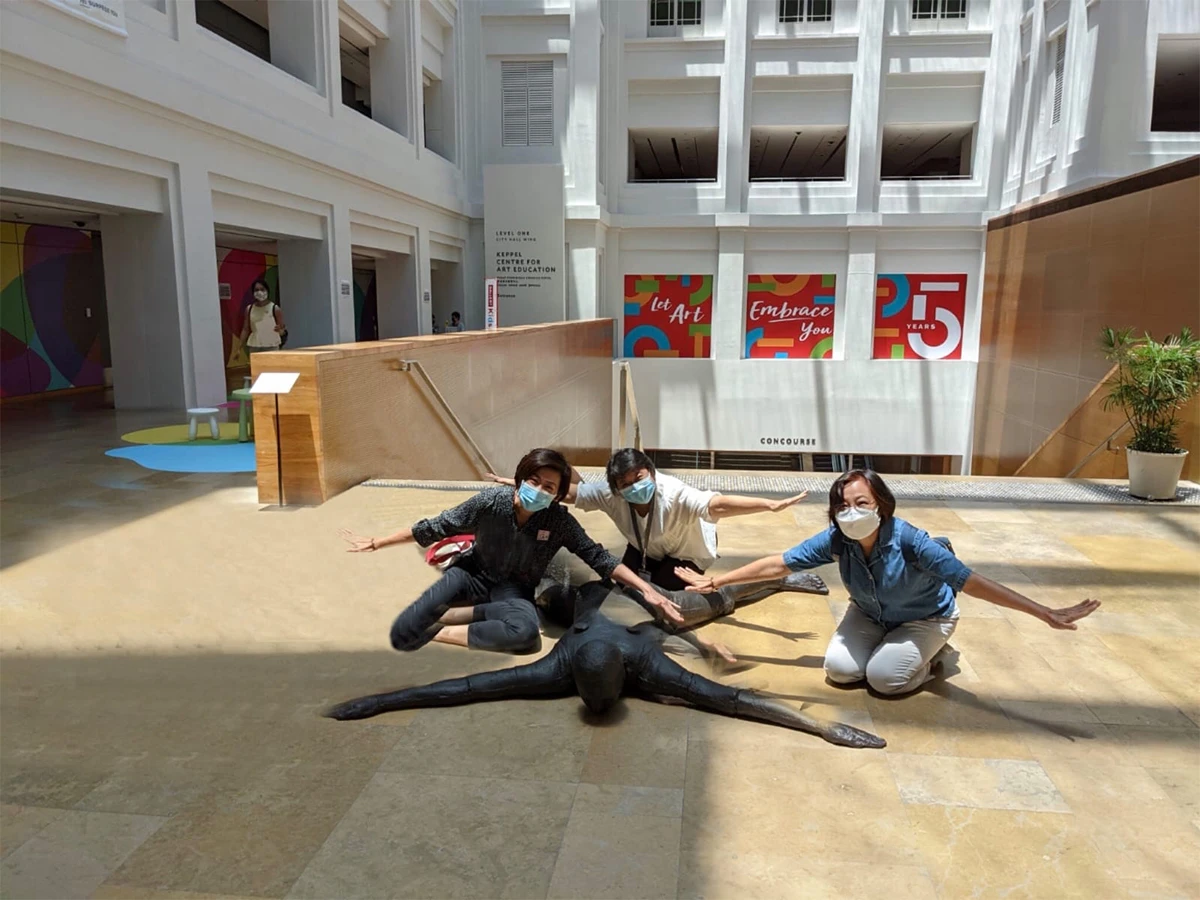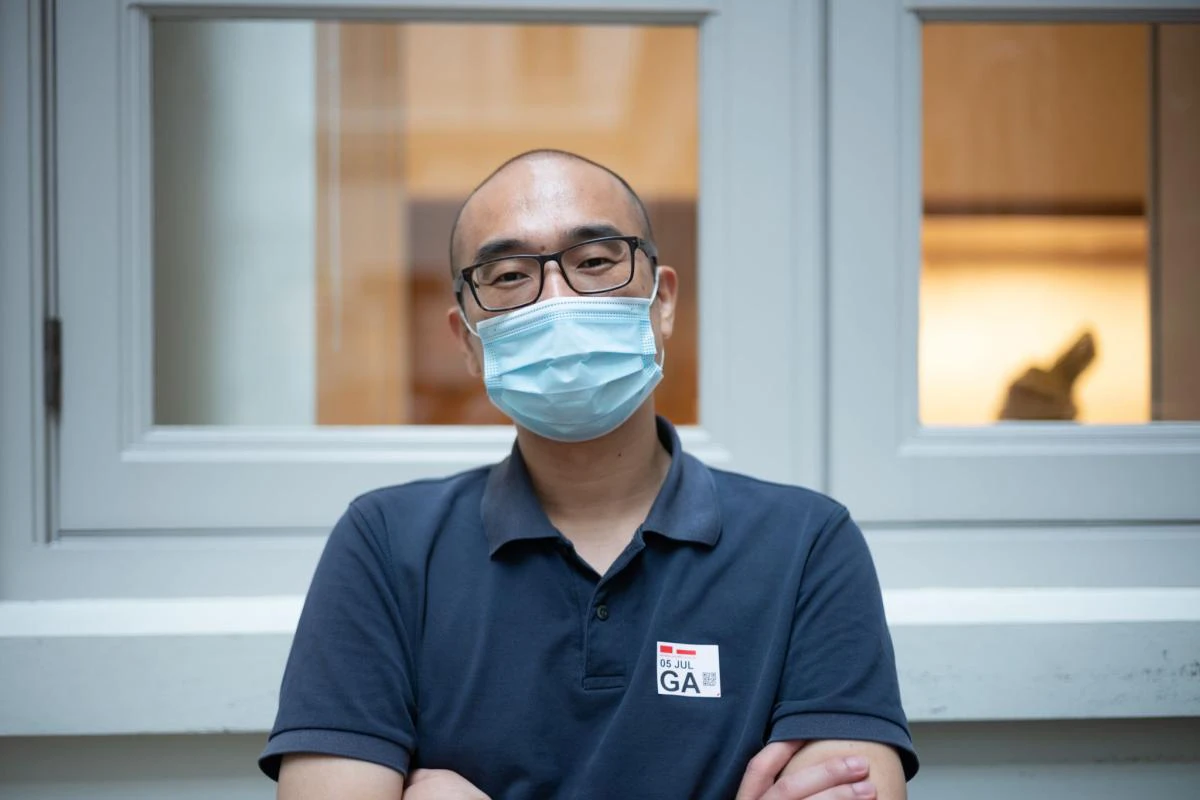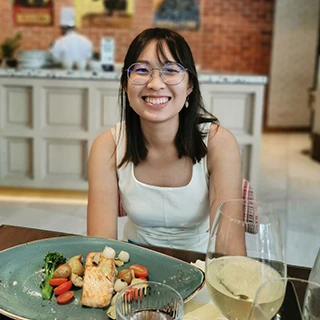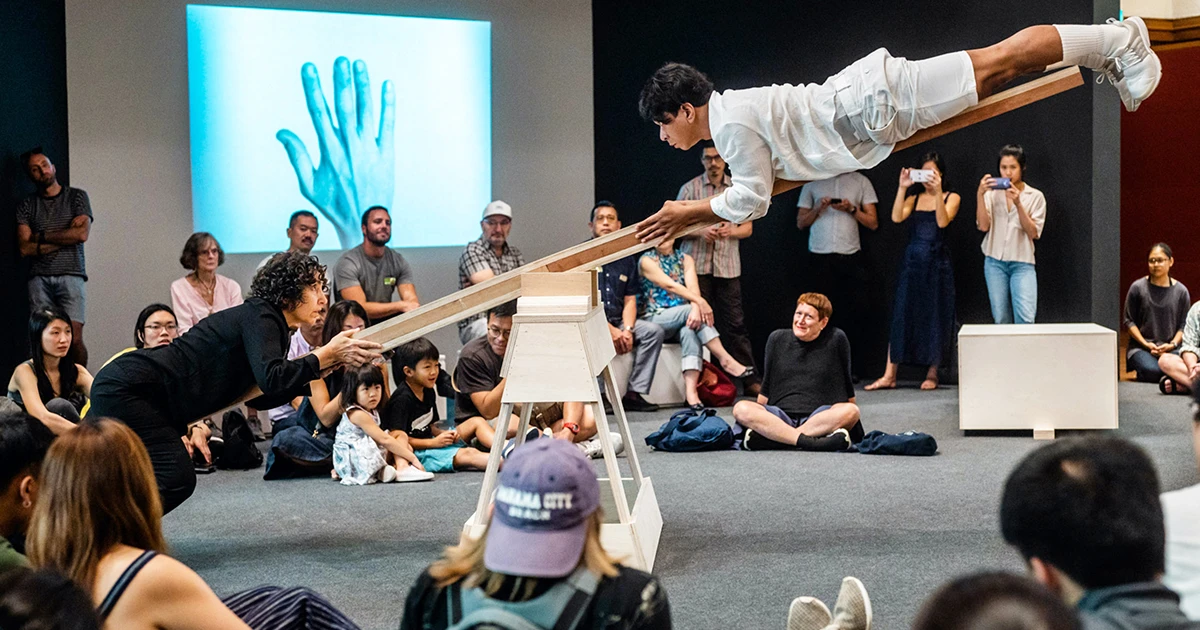Volunteer Voices: Growing with the Gallery
In this article, we chat with our docents Constance Ong, Mae Chong, Jacqueline Lim, and Eric Liu, about how they have grown with the Best Friends of the Gallery (BFG) programme. Through volunteering at the Gallery, they have picked up new skills which they have gone on to apply beyond the Gallery, as well as discovered new areas of interest.



Meet the Docents
Constance Ong: Constance is a docent at seven different museums in Singapore! Part of the Gallery’s pioneer batch of docents, she has been guiding at the Gallery for six years and counting. She guides a variety of tours, from community group tours to Art and Wellness programmes such as Slow Art Online.
Mae Chong: Like Constance, Mae guides at many museums in Singapore. In fact, Constance and Mae are friends. Their friendship started way back in 2003 when they met at Friends of the Museum (FOM). At the Gallery, Mae is often seen guiding the Building Highlights Tour, introducing participants to fun facts about the architecture of our monumental buildings.
Jacqueline Lim: Jacqueline has also been guiding for many years at various museums and art galleries, and first joined the Gallery as an English-speaking docent in 2015. Over the years, she has worked with the Gallery’s Community & Access team on community programmes such as Slow Art Online and Art with You.
Eric Liu: An engineer by training, Eric joined the Gallery in 2017 as a Mandarin-speaking docent. His core interest lies in modern art, and he often guides the Highlights of the Gallery tour on the weekends. He is frequently seen exploring new methods of making art interesting for friends who are wholly new to art.
Becoming a Docent
To be a docent at the Gallery, all volunteers must first undergo an extensive training programme. The programme, which can take from eight to eighteen months, equips would-be docents with guiding skills, art knowledge and architectural information. When asked about their docent training experience, Constance, Mae, Jacqueline and Eric had this to say:
Eric: 我觉得从导览员训练之中我是收益满多的。 从中,我学到很多新的技巧,比如说跟访客互动与发问的一些技巧。
[I learnt a lot from the docent training programme. I learnt many new skills, especially the facilitation skills and how to ask questions to engage tour participants.]
Constance: There was a lot of effort put into the Gallery’s training programme. I joined the training programme together with my Friends of the Museum buddies, but our group was split up. This encouraged me to make new friends, such as Yuqing. Throughout this training both my FOM and new friends helped me greatly, such as reminding me of deadlines and helping to explain certain art terms.
On the Gallery’s Community Programmes
Other than Daily Guided Tours, the docents have also been an integral pillar of the Gallery’s efforts to reach out to visitors from underserved communities as part of the Community & Access team’s work. These specially designed community programmes encourage participants to make meaningful connections with art, heritage, and the Gallery’s wealth of offerings. Some community programmes offered include: Slow Art Online, Art with You, and A-Health. A-Health is the Participatory Art-Based Activity of Health, and is part of a two-year study conducted by Nanyang Technological University (NTU), in collaboration with the Gallery, that seeks to understand how art and heritage can enhance the well-being and health of seniors in Singapore.
I asked Constance, Mae, Jacqueline and Eric how participating in these programmes have impacted them:
Constance: During these two years in the pandemic, many of the Gallery’s programmes had to move from being in-person to virtual. Through this I had many opportunities for new experiences and learning. The first was the Gallery’s Zoom training, conducted at the start of the pandemic, which taught me how to conduct engaging and interactive sessions on digital platforms. Two of these online Zoom programmes that I then volunteered for were Slow Art Online and Art with You.
The Slow Art Online programme was very interesting and actually piqued my interest in Art and Wellness, so much so that when Jacqueline recommended an external Slow Looking course, I decided to sign up for it together with her. Currently, I apply the facilitation skills I have learnt from the Gallery’s Slow Art training to most of my tours, including the 3 in 30 Tour. The 3 in 30 Tour is a festival tour conducted in line with the annual Light to Night Festival, and introduces three artworks in thirty minutes.
Additionally, I have participated in the Art with You programme as a facilitator. Due to the pandemic, the Art with You programme had to be converted from an in-person programme into a livestreamed tour and workshop experience instead. Through Pilot 2 of Art with You, I learnt the ropes on how to use livestreaming equipment as well as how to facilitate an in-gallery online tour, which was a new and exciting set of skills for me!
Jacqueline: Similar to Constance, I was also blessed to volunteer with the Art with You programme as a facilitator. When Art with You started, the Gallery team reached out to me to co-design a tour suited to persons with dementia. It was then that I did some self-study and subsequently applied to and was offered a fellowship by the National Gallery of Art in Washington, D.C. Working on, researching and designing this Art with You programme has sparked my interest in improving the wellbeing of persons with dementia.
After that, the Gallery collaborated with NTU to conduct the A-Health programme. This generated my interest in learning more about how to better engage seniors through art and museum experiences.
Mae: Unlike Constance and Jacqueline, I am not as involved in community projects. Instead, I mainly guide the Building Highlights tour. But one fine day, Constance, Jacqueline, and Jenny (a fellow docent) asked me to be part of A-Health. I agreed to do it because I thought it would be fun to be doing something with my friends! I would not have done it had they not asked me to join them. Initially, I was very worried about having to cover only three artworks in one hour. I thought I would not be able to fill the whole hour. However, during our practice run, I found it quite the opposite! One hour was hardly enough time to guide three artworks. Overall, it was a great experience working with my friends and guiding the community groups.
Eric: 我有参与Art with You的训练。 我觉得从中我收益满多的,但是挑战性也很大。 这个Art with You的顺练对我的触动也是满多的,从中我慢慢的学习跟不同人互动,学到了怎么通过艺术帮助有得到失智症的人。
[I took part in the Art with You training programme. I found the training to be challenging but I also learnt a lot. I learnt how to facilitate discussions and communicate with various groups of people, including how to engage people living with dementia meaningfully through art.]
On Transferring Their Skills
These community programmes and their accompanying training experiences have inspired our docents, and provided them with an avenue to learn new skills. Constance, Mae, Jacqueline and Eric have applied these skills to other areas of their lives, outside of the Gallery’s community programmes. When asked about transferring the skills learnt beyond the walls of the museum, they said:
Eric: 我觉得Art with You的训练对我的触动也是满多的,训练给我更多的动力去想尽办法让更多没有艺术背景的人能欣赏艺术。
[The Art with You training programme has given me exposure to different community groups that may not have an art background. As such, it has given me more motivation to explore new methods of making art interesting for those who may not have art background. For example, I am currently exploring how music inspires abstract art.]
Constance: During Pilot 2 of Art with You, I learnt how to use livestreaming equipment as well as how to facilitate an in-gallery online tour. After that, I roped Mae in for a livestream tour of they Life in Edo exhibition in Asian Civilisations Museum, for the docents at National Museum of Singapore. Both were a huge success and they had lots of positive feedback for us!
Jacqueline: Through participating in these community programmes, I learnt to use various features of Zoom, how to observe body language to better support participants, and how to listen actively. The initiative by the Gallery and Dementia Singapore to reach out to persons living with Dementia propelled me to seek more knowledge. When I interact with the seniors during the Art with You sessions, I realized that there are actually a lot of things we can do for them. Many times, there is a lack of activities for mental stimulation and social interaction for persons with dementia, as they are told to stay home in case they get lost. So this programme is very meaningful. However, at the same time, I still had a lot of unanswered questions. As such, I asked for an internship at a nursing home, in their dementia ward.
Then, NTU came along to partner with the Gallery for the A-health project. I thought that it was a great study because it catered not just to people living with dementia, but to a larger mass of active, healthy seniors. It was through A-Health that I came across the Masters of Science in Applied Gerontology that NTU offers, and eventually decided to go back to school to learn more!
Mae: A-Health was the first community programme that I participated in. Through this programme, I am now more open and confident to trying new things! I am usually one who thinks twice before diving into something new; I was not confident of guiding art tours because I felt like I did not have enough knowledge to do so. However, because of my friends who invited me to join the programme, I am now more open to trying out guiding other tours and programmes.
On Friendship and Networks
An important aspect of the docent training and community programmes for Constance, Mae, Jacqueline, and Eric, were the friendships built and communities created during the process. When I asked about them about the new friends they made and the communities that arose out of their volunteer training experiences, our docents excitedly shared:
Jacqueline: Through all the programmes at the Gallery, such as the docent training and community programmes, I met fellow docents, which eventually became good friends. It has been really enjoyable.
Eric: 从导览训练中我认识到很多朋友。 一方面学习到很多技能,然后一方面就是认识到很多有相同兴趣的朋友。当时有跟这些朋友讨论,一起学习。虽然已经过了几年,我们还是经常有约在一起。
Another major takeaway from the docent training programme were the friendships forged with other docents. Oftentimes, we huddled together after the lectures and trainings to discuss what we have learnt. Even though it has been a few years since the training programme, we still meet regularly.
Constance: I do really enjoy hanging out with friends. Being part of the Gallery’s BFG programme gave me an avenue to catch up with old friends and foster new friendships!
Jacqueline also introduced me to many online courses which I really enjoy. It is very good to have a “Kang Taw!”!1
Mae: Having little knowledge about art, it was really the social aspect of the BFG programme that attracted me to being a docent in the Gallery; it is also a huge reason for my continued participation.
My FOM friends really helped me pull through the docent training programme. I am also very thankful to Constance and Jacqueline for inviting me to be part of the community programme which then enabled me to experience new things.
The BFG Programme
All in all, when asked what they thought of the Gallery’s volunteer programme, and what motivated them to continue volunteering with the Gallery, our docents shared enthusiastically:
Constance: Volunteering at the Gallery is fun and meaningful! I really like that the Gallery is reaching out to the community. Art in the community is really something I really like to support!
Jacqueline: My time at the Gallery has helped me foster companionship and make a difference to different community groups.
Mae: The Gallery’s programmes are meaningful! They are great social activities that have also enabled me to try new things!
Eric: 我觉得做导览员的经历非常好。 我现在做的次数越来越多,一年比一年多。还有我觉得今年比较特别的事,我有认识一些访客朋友,他们会回来找我, 这让我觉得很开心。这给我更多的动力研究更多的画作,更想多些不同的方式来分享现代艺术。
[The volunteering experience at the Gallery has been great. In fact, I have been guiding at the Gallery more frequently as the years go by. One special thing that made me delighted this year is that I got to know a few participants from my tours, and they revisited the Gallery multiple times. This gave me motivation to do more research on the artworks and think about how I can use different ways to present modern art.]
Notes
1 A colloquial term referring to a friend with lots of connections.
Our volunteers are important stakeholders, and the Gallery is grateful for how they continuously adapt to these uncertain and everchanging times. Moving forward, we hope to continue to train our volunteers and equip them with skills that they can use in their daily lives. By providing our volunteers with a platform where like-minded individuals can meet, the Gallery is also working towards its mission of creating an art-loving community of bonded individuals. If you are interested in volunteering with the Gallery, visit this page to find out more about the opportunities available.













